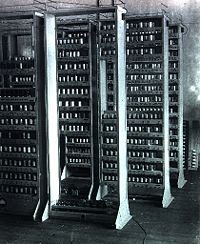 A computer is a machine that manipulates data according to a list of instructions.The first devices that resemble modern computers date to the mid-20th century (1940–1945), although the computer concept and various machines similar to computers existed earlier. Early electronic computers were the size of a large room, consuming as much power as several hundred modern personal computers.
A computer is a machine that manipulates data according to a list of instructions.The first devices that resemble modern computers date to the mid-20th century (1940–1945), although the computer concept and various machines similar to computers existed earlier. Early electronic computers were the size of a large room, consuming as much power as several hundred modern personal computers.
Modern computers are based on tiny integrated circuits and are millions to billions of times more capable while occupying a fraction of the space. Today, simple computers may be made small enough to fit into a wristwatch and be powered from a watch battery.
Personal computers, in various forms, are icons of the Information Age and are what most people think of as "a computer"; however, the most common form of computer in use today is the embedded computer. Embedded computers are small, simple devices that are used to control other devices — for example, they may be found in machines ranging from fighter aircraft to industrial robots, digital cameras, and children's toys.
The ability to store and execute lists of instructions called programs makes computers extremely versatile and distinguishes them from calculators. The Church–Turing thesis is a mathematical statement of this versatility: any computer with a certain minimum capability is, in principle, capable of performing the same tasks that any other computer can perform.
Therefore, computers with capability and complexity ranging from that of a personal digital assistant to a supercomputer are all able to perform the same computational tasks given enough time and storage capacity.
EDSAC was one of the first computers to implement the stored program (von Neumann) architecture.




No comments:
Post a Comment